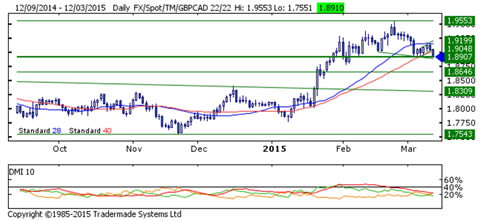Sterling Weakness v Canadian and Australian Dollars Temporary say Analysts
Above: Analysts Kathy Lien and Kathleen Brooks.
The pound sterling (GBP) is finding March to be a tough month against the commodity currency complex with losses being seen against both the Canadian and Australian dollars.
However, all signs point to this weakness being temporary with 2015 being tipped as a year that will ultimately favour sterling.
As we note here, the Bank of England should ultimately embark on a pro-GBP interest rate raising cycle.
A great deal of Sterling weakness is being seen against the US dollar in particular.
“GBPUSD fell like a stone on Thursday and crashed through the critical 1.4950 level against the US dollar,” notes Kathleen Brooks at Forex.com summing up what has been a poor March for the UK unit.
It must be stressed however that the dynamic seen against the Greenback is ultimately different to that seen against other currencies so while GBPUSD weakness is likely to persist the UK currency could flourish elsewhere.
Why the CAD and AUD are Susceptible to Declines v Sterling
Sterling continues to fall and its weakness can be seen not only against the U.S. dollar but all major currencies as we move through mid-March.
Granted, this observation is at odds to our previous statement in which we suggested GBP-USD stands apart from other sterling currency pairs.
Here is why.
Central bank policy and interest rates are the ultimate drivers of currency valuations, this graphic will help you understand how and why more clearly.
Bank of England Governor Carney has said that while a strong currency could drive down inflation he repeated that the Bank’s outlook is consistent with gentle rate rises.
“In other words, the BoE is still looking to raise interest rates which means that the lower the British pound falls, the better entry it provides for long term traders,” says Kathy Lien at BK Asset Management.
Lien says buying sterling versus the dollar is less attractive than buying it against other currencies such as the euro, Australian or Canadian dollars.
Pound Sterling Forecast: GBPCAD Short-Term Pressures Build
Sterling enjoyed a power run against the Canadian unit as the New Year got under way.
The boost came amidst a well-publicised decline in global oil prices – a key component of the Canadian export mix.
However, the bullish run has come to an end and given way to consolidation; more losses could come says analyst Shaun Osborne at TD Securities:
“February/March lows are under pressure and the neckline of the potential H&S reversal highlighted previously looks at risk.
“We noted earlier this week that the loss of the 40-day MA would be GBP-negative and, with price doing a lot of damage to the charts today, significant downside risks are building here.
“The bear flag formation suggests scope for a drop back to 1.85—broadly in keeping with a stiff retest of the 2014 high (1.8645) and the major, long-term bull break out seen earlier this year at 1.8309 currently.”
The price action in GBPCAD described here is consistent with Lien’s view that declines in sterling offer good entry points for longer-term trades.
2015 should be a year within which the pound outperforms as the Bank of England leans on raising interest rates.
The CAD should ultimately fall back to longer-term trend levels against GBP as a result.
Indeed, we hear from a host of institutional sources that coming months will not likely favour the CAD.
Essentially, the Bank of Canada has not done enough to stimulate the economy.
In January the currency slumped in response to a surprise cut to 3/4’s of a percent in the overnight rate.
However, “we see significant unpriced risks of additional, much needed, stimulus from the BoC,” warns Aroop Chatterjee in a note to clients.
Australian Dollar Strengthens, However Uptrend in GBPAUD Remains Alive
The same dynamics in GBPCAD apply to GBPAUD.
We reported here yesterday that the outlook ultimately favours the British pound against the Aussie dollar, the rise being defined by an established uptrend.
The value of the Aussie currency remains problematic for policy-setters at the Reserve Bank of Australia (RBA) who see the AUD as being too high.
As such risks remain that the RBA will continue its campaign to weaken the currency.
We ultimately see this campaign facilitating a move by the pound to Australian dollar exchange rate back above the 2.0 region.
RBA board minutes are due Tuesday and we will be looking for any indication of when the RBA might next cut rates, where we expect the next move to come in May.
“However, the RBA may not give much away, and we think it more likely that the bank will simply repeat its strong easing bias. As for the currency, the RBA has previously argued that the exchange rate was significantly overvalued relative to the fundamentals,” says Kieran Davies at Barclays.
This is no longer the case, in that staff documents recently released under the Freedom of Information Act reported that the currency was only 2% expensive in Q1 to date based on the RBA’s own fair value model.
According to Davies this setback will unlikely hold the RBA back from trying to stamp the Aussie yet lower.
The way the RBA has handled this is to reframe its criticism of the high exchange rate, with Assistant Governor Kent now arguing that the “exchange rate remains relatively high given the state of our overall economy”.
“This suggests to us that the RBA would be comfortable if the exchange rate overshot fair value – say, by falling to 70 US cents or lower – which seems possible given that its fair value model shows that once the currency reaches fair value it hardly ever spends any time there,” says Davies.
Risks certainly lie ahead for the Aussie and as such the longer-term game plan remains to back the GBP-AUD’s trend higher.






